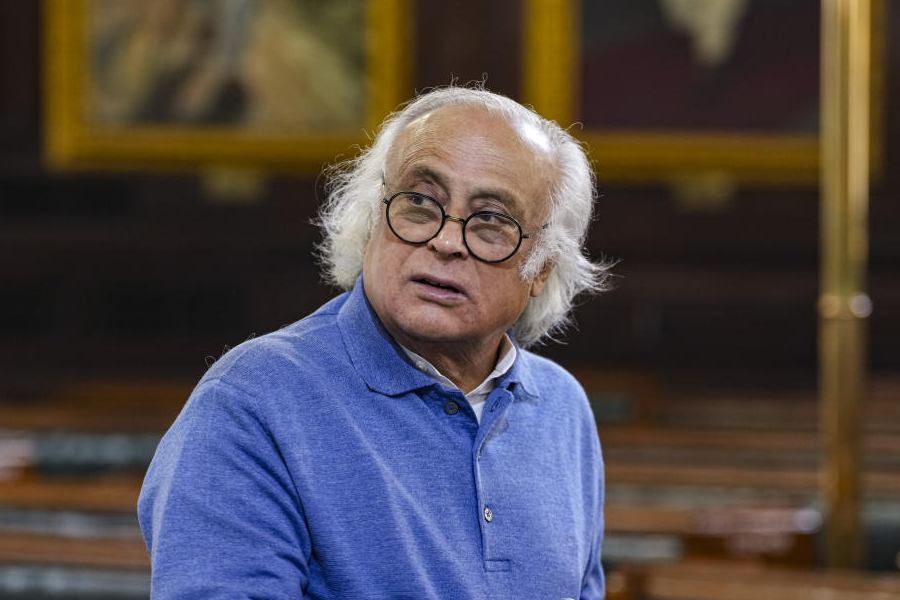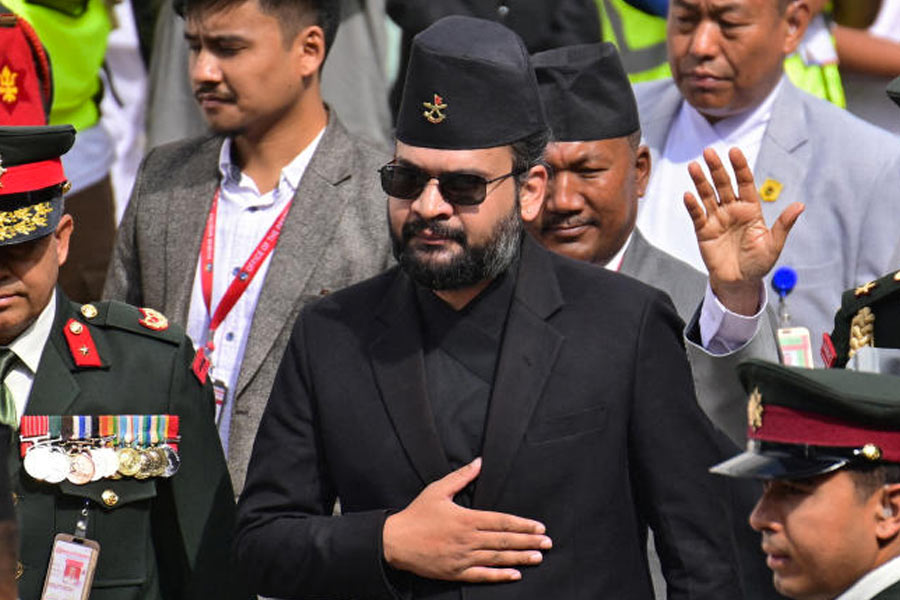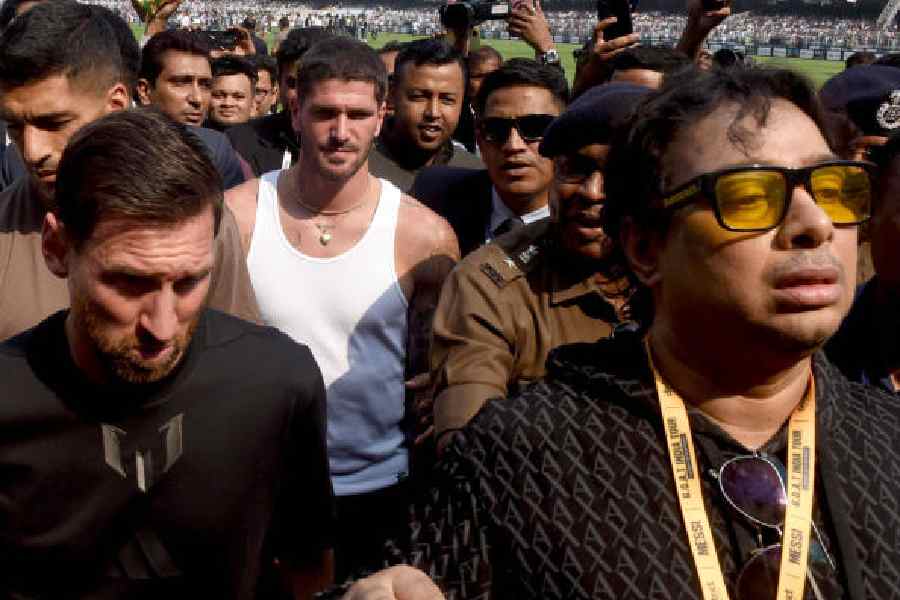Industrial stupor
Unlike in 2011, the clarion call in 1977 was janaganatantrik biplob (people’s democratic movement). Kanailal Bhattacharya, a Forward Bloc leader, was handed charge of the industry ministry when the Left first came to power in 1977 with the promise of giving a better deal to the poorest of the poor in the state. The stalwarts of the CPM — even then the dominant force in the Front — kept other departments like labour, land and land reforms. As industry slipped down the list of priorities, industrial relations plumbed a new low and militant trade unionism resulted in a flight of capital. The situation prevailed till 1993, when the Left under Jyoti Basu came up with a New Economic Policy. But the state had to wait till 2006 to get an industry minister who is also a party heavyweight
English blunder
In 1983, six years after coming to power, the Left Front banned the teaching of English till Class VI even as the children of Left leaders got enrolled in English-medium schools. The government justified the ban by citing a recommendation of the Himangshu Bimal Mazumdar Commission constituted during the Congress government in 1975 that had said that the teaching of two languages to children till Class VI would be tortuous and unscientific. But one of the primary intentions of abolishing English was to increase enrolment of students in primary classes in state-aided schools located in rural districts as the Left leaders wanted to earn brownie points with higher enrolments. Increasing the success rate in Madhyamik was another motive behind undermining English teaching in state-aided schools.
The secondary-level English syllabus was also restructured to make it more simple, although students from the state continued suffering in all-India examinations and in other spheres of life. The Pabitra Sarkar Committee was set up in 1999 to examine whether it was necessary to reintroduce English at primary level. Based on the committee’s findings, English was restored to Class I in 2004.
Calcutta’s decay
The Left Front government turned Bengal into a one-city state. The first thing the Left Front government did after coming to power was expand the geographical spread of the city by adding 41 wards of Behala, Garden Reach and Jadavpur. The move was aimed at securing Calcutta as a Left stronghold by adding wards where it had always enjoyed majority.
An unplanned real estate boom started in these areas as Left leaders turned a blind eye to the phenomenon of filling up ponds and water bodies. Buildings came up in these areas but no support infrastructure — road and sewer lines — was created. The Left civic boards did little to clear the slums — the city has over 4,900 slums — as slum-dwellers emerged as the main vote bank for the front.
Another populist move was giving the hawkers a free run on the pavements that further shrunk the city’s roadspace. Instead of working on a proper urban transportation plan, the Left government introduced autorickshaws to the streets of Calcutta that added to the chaos and poisoned the air.
Health care horror
Perhaps in no other field has the Left government let down the poor than in health care. Primary health care centres in Bengal became horror stories symptomatic of all that was wrong with the way the front ran its government.
The state government failed to create an effective primary and secondary health care infrastructure in Bengal. If there is one doctor for 2,083 patients in the country, there is only one doctor for 3,964 patients in Bengal. If at all doctors were posted in rural centres, absenteeism became an endemic problem.
The “sick wagons” chugging out of Howrah railway stations, packed with patients headed to south India, is a sorry statement on how the Left failed to channel investments into health care. In district hospitals, most doctors are compelled to refer even caesarean deliveries to a medical college in Calcutta.
Since 1977, hardly any infrastructure has been created for cardiology, nephrology, psychiatry and haematology in the rural areas. For a by-pass surgery or dialysis, patients from the villages will have to come to Calcutta or go outside the state.
Another failure of the Left government has been its inability to create infrastructure for medical education. In the past 34 years, only three medical colleges have come up in Bengal, two of which were set up by the government. In Karnataka in the past 10 years, more than 15 medical colleges have come up, six of which were set up by the government. In Maharasthra in the past 15 years, 17 medical colleges have been set up, of which five are government-run.
Police politics
In 1979, Jyoti Basu had a brainwave: inject politics into a disciplined force by forming the Calcutta Police Association. It also paved the way for the formation of non-gazetted unions in the district police lines. With most promotions and postings defined by political equations, the personnel in uniform became an extension of the party. Handpicked officers were busy serving the interests of the government and the party, leaving corrupt and inept officers to call the shots in law and order management.
The administration’s failure in not just tackling problems but also in preventing conflicts from snowballing into crises — be it in the hills or in places like Nandigram — shows the pitfalls of breeding an inefficient system.
Cadre raj
1977 did not mark the beginning of a long Left innings alone, it also heralded an unending season of thanksgiving. A grateful Left government repaid the cadres by creating government jobs, never mind if they were needed or not. A government workforce of over 10 lakh, one of the biggest such collections across the country, was built. The recruitment drive was launched from the third year of the government coming to power. It continued till August 2010, filling various directorates like food and civil supplies, agriculture, fire services and youth services with recruits.
Although written examinations were held to select the candidates, allegations were rife that only party cadres and their relatives got jobs. As several families with more than two to three government employees can be found almost everywhere in the state, the accusation of nepotism cannot be dismissed as wild. The reckless drive not only bled the coffers dry but also killed meritocracy in the state.
Big fat cabinet
As keeping the flock together was an overriding concern of the Left Front that came to power in 1977, it created slots for 30 ministers — including cabinet and ministers of state — to park its own MLAs and those from the allies. When the government ran out of ministries, it improvised. For instance, several ministries were carved out from education — school education, higher education and technical education, not to mention a library minister.
Over the years, the Left fine-tuned the carving to perfection and the number of ministries swelled to 43. A fire services department — the only such department across the country — rose from the furnace of such creative thinking. Housing was stripped from PWD. Micro departments that dealt with western region development, mass education and madarsa and minority affairs were chiselled.
As accommodating allies was the main concern, the government also created departments like water resources and disaster management.
Education czar
The first Left government set a target to establish control on each and every primary and secondary school in Bengal. To achieve the target, the government decided to bear the entire expenditure for running the institutions. Although the merits and demerits of the move can be debated, there is little doubt that the government largesse for all the schools strained the education budget. The centralised education system also cast a shadow on the quality of education.
In 1977, there were around 40,941 primary schools, 3,201 junior high schools (till Class VIII), 3,661 secondary schools and 967 higher secondary schools. In 1982, each of these schools were brought under the government’s grant-in-aid scheme for providing full financial assistance for paying salaries to teachers. The government also abolished tuition fees of students till Class VIII studying in the state-aided schools.
The government control resulted in recruitment of party cadres in these schools, who became the backbone of the Left’s support base. Apparently, the move to have full control of all state-aided private schools was intended to increase enrolment by attracting more students from middle class and lower middle class families. But the policy was also aimed at making political gains. Since the schools received full grant from the government, they were bound to follow its language policy and allow teachers and non-teaching staff to participate in CPM unions.
Union infiltration
As the objective was to retain control over educational institutions — from schools to universities — the Left leaders placed emphasis on penetrating the institutes through unions. The effort did pay off as teachers’ unions in Bengal played a big role in safeguarding the policies of the Left Front government even if they were faulty and not acceptable to the student and teaching communities.
In an attempt to take the teaching community into confidence, the Left Front pulled out all stops to increase the membership of the CPM-controlled teachers’ bodies — such as the All Bengal Teachers’ Association (ABTA), the All Bengal Primary Teachers’ Association and the West Bengal College and University Teachers’ Association.
The inclusion of teacher representatives in the executive committee of the state-run West Bengal Board of Secondary Education and West Bengal Council of Higher Secondary Education is a glaring example of how the CPM-led government used teachers for advocating its policies.
In the mid-1980s, the government amended the rules to incorporate teacher representatives in the Madhyamik board and HS council. The teacher representatives in the board and council are now selected from among the ABTA members. Similarly, the number of teacher representation in the managing committees of schools, senate and syndicate were also increased. At present, these bodies hardly have teachers owing allegiance to non-Left bodies.
Work culture, RIP
After a motivational lecture on fast-tracking delivery of government projects, a senior IAS officer in North 24-Parganas had told his superior: “Sir, if you can please motivate the people with whom I work, we will deliver ahead of schedule.”
The young IAS officer had placed the request because his effort to speed up work was repeatedly running into a resistance from employees. He sought the good offices of the leaders of the co-ordination committee but they pleaded helplessness.
The officer’s plight is a telling testimony to how the government never told its employees that they had certain duties to discharge in a time-bound manner. By the time Buddhadeb Bhattacharjee coined “do it now” and tried disciplining the workforce, it was too late as the state’s work culture had been destroyed by then. Not only did government work suffer but the lethargic state of affairs also generated an impression inside and outside Bengal that nothing ever gets done in the state.
Party control
When a Bengal Congress leader once asked chief minister Buddhadeb Bhattacharjee whether he was a “bonded labourer” and always toed the party line, he had said: “Right you are. I am bonded with Alimuddin Street.”
The chief minister’s answer sums up how the party played an over-arching role in governing the state. In Bengal, the communist practice of the party running the government began shortly after the Left Front government took over in 1977.
However, Jyoti Basu, the then chief minister whose writ ran large in the party, had crossed swords with then CPM state secretary Promode Dasgupta on the party’s “day-to-day interference” in the government’s work. So much so that Basu had refused to create teaching posts to accommodate the party faithfuls when PDG was insisting on that. But finally, PDG’s writ stayed and that became the norm.
Although the government was run from Writers’, the remote control had always been at Alimuddin Street, where the state CPM headquarters is located. Be it the appointment of vice-chancellors or postings of IAS and IPS officers, all major administrative decisions needed the nod of Alimuddin Street.
Petty tactics
Playing to the gallery for short-lived applause became a pastime for the Left. Nothing illustrates this better than renaming Harrington Street — home to the American consulate — as Ho Chi Minh Sarani. A better way of settling scores with America would have been to take care of the poor in such a manner that the capitalists would have had little option but to admire Bengal. If governments ruled by other parties in other states had followed a policy of rechristening streets where CPM offices are located, the party would have been safe in only three states in the country. The party eventually ate humble pie when its leaders had to bend over backwards before capitalists to court investments.
The paucity of ideas was also on display when the Left unveiled a statue culture. If they can’t get a job, let them admire the Lenin statue and salivate about the golden days that revolution will bring one day.
THE GOOD INTENTIONS
Land reforms
The Left government successfully implemented land reforms that changed land relations in Bengal. The reforms took shape in the form of redistribution of vested land and securing tenancy through a programme of universal registration of tenants, called Operation Barga. The effort was accompanied by effective institutionalisation of decentralised democracy through a three-tier panchayat system.
According to the budget statement of 2011-12, in the past 34 years (up to January
15, 2011), 11.32 lakh acres were distributed, benefiting 30.44 lakh farmers. The report claimed that 66 per cent of the beneficiaries belonged to Scheduled Castes, Scheduled Tribes and minorities.
The benefits of land reforms were visible in gains in agriculture. During the period between 1980-81 and 1999-2000, the annual rate of growth of foodgrain production in the state was 4.1 per cent against an average of 2.5 per cent for all major states.
Clean image
One of the biggest assets of the Left Front government has been the clean image of its leaders.
While corruption scandals involving chief ministers and cabinet colleagues of other states kept tumbling out, the Left Front steered clear of such controversies. The rise of Jyoti Basu’s son Chandan as a businessman often embarrassed the government and the party but the personal integrity of Basu was rarely called into question. The same can be said of Buddhadeb Bhattacharjee and most of his cabinet colleagues. The Spartan lifestyle of prominent Left leaders — from Promode Dasgupta to Biman Bose — gave the party credibility among the poorest of the poor.
Communal harmony
One of the biggest successes of the Left Front government has been creating a tolerant
society, where large clusters of people from different religions could co-exist without conflagrations. Although some critics of the Left claim that Bengal had a secular past, there is little doubt that the Left Front leaders did their best to preserve the tradition. Bengal remained an oasis of peace even during the Babri Masjid demolition, when riots broke out in several parts of the country.
Cosmopolitan culture
The Left Front should get accolades for preserving the cosmopolitan tradition of Calcutta, which till 1911 was the capital of India. Although most of the big businesses in Bengal were held by Marwaris, the Left Front never inflamed sectarian passions for political gains. Poor industrial relations saw the flight of capital, but Marwaris, Gujaratis, Punjabis and other communities stayed back and still call Bengal their home. Bengal also has taken care not to make people from other states feel they are outsiders, unlike the Shiv Sena and its offshoots in Maharashtra.
Buddha did tryAfter spending almost two decades in power, the Left Front under Buddhadeb Bhattacharjee realised that industrial growth was the precondition for a better future for Bengal. Slogans like krishi amader bhitti, shilpo amader bhobisyot (agriculture is our foundation and industry is our future) were coined as Bhattacharjee tried wooing investments to Bengal. The effort started by employing McKinsey to project Bengal as an investment destination. Bhattacharjee, along with his cabinet colleague Nirupam Sen, aggressively pitched for investments, and investors started looking at Bengal with interest. The government competed with other states to get Tata Motors to Bengal for the Nano project in Singur. Although in the face of opposition from Mamata the project was finally shifted to Sanand in Gujarat, the government did not deviate from its objective of pursuing private investments.
Privatising education
The Left Front was against privatising engineering and medical education and did not accept the Centre’s proposal to set up private engineering and medical colleges in the state in the late 1980s. Maharashtra, Uttar Pradesh and other states in the south had accepted the Centre’s policy and allowed private players to set up engineering colleges. The number of engineering seats in these states increased considerably, drawing students from Bengal, too.
Alarmed at the exodus in the mid-1990s, the government was forced to change its policy and allowed private engineering institutions in the state.
The decision to privatise medical education was also finalised much later.
Power push
“Load shedding” was a phrase that defined Calcutta when the Left Front formed its first government. In 1977, the state’s total generation capacity was around 1,360MW and the peak demand around 1,100MW. Recurring glitches and under-performance of variousunits saddled the state with a shortfall of around 300MW in summers.
Efforts by the government during the tenure of three power ministers — Jyoti Basu, Prabir Sengupta and Sankar Sen — set the stage for a gradual turnaround in the mid-1980s. The state now generates over 7,100MW against a peak demand of around 6,900MW. Except during phases when quality coal supply is stymied or there is a technical glitch, Calcutta hardly sees a blackout. The government also entered into agreements to share power with neighbouring states and buy power from utilities like NTPC. The state’s performance in rural electrification, however, remains dismal.
the teacher cost
The teacher constituency served the interests of the Left but not financial prudence. In 1977 the state government spent Rs 114 crore on education. By 2010-11, the education bill had ballooned to Rs 13,622 crore. The expenditure would have been laudable had the amount been spent on building infrastructure and drawing more children to schools. But more than 80 per cent of the funds are meant for paying teachers’ salaries










